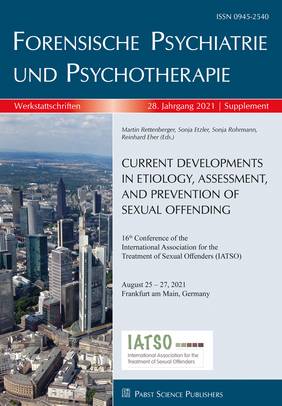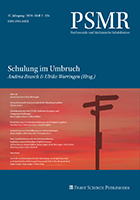Inhaltsverzeichnis
Prevalence of ICD-10 pedophilia in a Danish sample of sexual offenders
Ali Farzdaq Mohammad Al-Dehlagi, Ellids Kristensen, Annamaria Giraldi & Susanne Bengtson
The landscape of human sexuality – Modelling distances among various arousal patterns using a sociomapping technique in online representative Czech sample
Renáta Androvičová, Eva Höschlová, Klára Bártová, Lucie Krejčová, Cyril Höschl & Kateřina Klapilová
Treatment of juveniles who have sexually offended: A RCT-validation of an outpatient treatment program based on social skills training vs. specific relapse prevention techniques
Marcel Aebi, Chiara Krause, Steffen Barra, Gunnar Vogt, Leonardo Vertone, Madleina Manetsch, Daniela Imbach, Jérôme Endrass, Astrid Rossegger, Klaus Schmeck & Cornelia Bessler
Distorted beliefs linked to sexual offending
Ross Bartels
Experimental investigation of emotion regulation problems in sex offenders against children
Dominika Bartoszak, Filip Szumski & Krzysztof Kasparek
The development and content of the guided web-based intervention @myTabu for individuals who sexually abused children and individuals who consumed child sexual exploitation material
Louisa Bauer, Sonja Schröder, Safiye Tozdan, Bruno Siegel, Jürgen L. Müller & Peter Fromberger
The importance of the biological and social model for the aetiology of paedophilic interests in child sexual offenders
Maria Beisert, Monika Zielona-Jenek, Olga Węglerska & Marzenna Zakrzewska
Intergenerational co-occurrence of sexual offending – A case-control study
Susanne Bengtson, Jens Lund, Michael Ibsen, Ellids Kristensen & Niklas Långström
Aggressive sexual fantasies as a risk factor for sexual coercion: Replication and further development of an etiological model
Joseph Bernhard Birke, Patrick Jern, Ada Johansson & Rebecca Bondü
Family treatment of sexual violence
Wayne Bodkin, Magali Teillard Dirat, Céline Bais, Mathieu Lacambre, Cyril Manzanera, Julie Kirsnewaz, Cindy Prud’homme & Marie Mesguish
Individualized treatment of sexual offenders with an intellectual or developmental disability
Douglas P. Boer
Zur Rolle von Recht und Kriminologie beim Umgang mit Sexualdelinquenz
Hauke Brettel
Does psychodynamic thinking still have any significance for the treatment of pedophilia?
Peer Briken
“Talking about it instead of suffering from it” – Paraphilic development in adolescents
Fabiola Casademont, Viktoria Märker & Peer Briken
French helpline for minor attracted persons: Preliminary data
Marie Chollier, Mathieu Lacambre, Ingrid Martin-Bertsch, Cécile Miele Florent Cochez, Eva Massiani, Sabine Mouchet-Mages, Walter Albardier, Roland Coutanceau, Daniel Pinède, Barbara Thomazeau, Baptiste Oriez & Anne-Hélène Moncany
Examining professional attitudes toward individual with sexual interest in children
Carisa Collins & Leigh Harkins
Facilitating help-seeking behavior in users of the Stop it Now! Helpline
Minne De Boeck & Ellen Janssen
Understanding somnophilia and dormaphilia
Elizabeth Deehan & Ross Bartels
Hostile masculinity and emotional negativity as mediating factors in hostility toward women
Caroline Deli, Étienne Garant, Alexandre Gauthier & Jean Proulx
Sexualstraftäter in der Sicherungsverwahrung
Axel Dessecker
Untangling the cognitive correlates of emotion recognition deficits in sexual offenders that committed offenses against children
Tineke Dillien, Inti A. Brazil, Bernard Sabbe & Kris Goethals
Sexueller Missbrauch in der katholischen Kirche
Dieter Dölling
Der Zusammenhang kognitiv verzerrter Sichtweisen mit dem Vorliegen einer pädosexuellen Präferenzstörung
Sabrina Eberhaut
20 Jahre Sexualtätermanagement in Österreich – Die Auswirkungen geeigneter legistischer Rahmenbedingungen und der Adhärenz am RNR Prinzip auf die Reduktion der Rückfallraten
Reinhard Eher
Aktuelle Entwicklungen in der Anwendung des Static-99, Stable-2007 und VRS:SO im deutschsprachigen Raum
Reinhard Eher
Gründe für staatsanwaltschaftliche Einstellungen bei Fällen sexueller Gewalt
Jutta Elz
Using antiandrogens in perpetrators of sexually motivated crimes in Turkey – current legal situation
Rahime Erbaş
Why do people send unsolicited sexual images?
Rebecca Fisico & Leigh Harkins
e-Health-apps for the risk-assessment and treatment of child abusers
Peter Fromberger
e-Health-Apps in der Diagnose und Behandlung von Sexualstraftätern
Peter Fromberger
@myTabu – A web-based intervention for individuals who sexually abused children and individuals who consumed child sexual exploitation material
Peter Fromberger, Louisa Bauer, Sonja Schröder, Bruno Siegel & Jürgen L. Müller
The mediating role of psychopathology in the emergence of deviant sexual fantasies in sexual aggressors of children
Étienne Garant, Alexandre Gauthier, Caroline Deli & Jean Proulx
Life path trajectories leading to deviant sexual fantasies in sexual aggressors of women
Alexandre Gauthier, Caroline Deli, Étienne Garant & Jean Proulx
Organisation and quality criteria of sex offender community treatment in Belgium
Kris Goethals & Minne De Boeck
The World Federation of Societies of Biological Psychiatry (WFSBP) 2020 Guidelines for the pharmacological treatment of paraphilic disorders: A workshop for psychologists and psychiatrists
Kris Goethals, Florence Thibaut, Paul Cosyns, John Fedoroff, Peer Briken & John Bradford
A walk in the park: The association between psychopathy and vulnerability detection using virtual reality
Jean-Pierre Guay & Angela Book
Exploratory results about specific needs and child molesting: Differences between subtypes of offenders
Cláudia Gouveia, Marta Sousa & Rui Abrunhosa Gonçalves
Can characteristics of crime scene behaviour improve predictive accuracy of Static-99R?
Marcel Guéridon, Kristina Straßburger & Stefan Suhling
Incorporating sociocultural and situational factors into explanations of sexual offending
Leigh Harkins
Development of the multi-trajectory model of sexual murder
Tamsin Higgs
Multiple perpetrator and multiple concurrent victim sexual homicide
Tamsin Higgs, Jonathan James & Jean Proulx
Qualitätssicherung der Behandlung von untergebrachten Sexualtätern und Evaluation der Sicherungsverwahrung – Erfahrungen aus Sachsen
Sylvette Hinz
Countertransference counts in the multidisciplinary team – Psychodynamics still alive in forensic psychotherapy
Klaus Hoffmann
Pedohebephilic men report both more negative and more positive memories of childhood sexual abuse than controls in two online surveys
Sara Jahnke, Juergen Hoyer & Alexander F. Schmidt
The Paraphile project: Primary prevention program for people with paraphilia and their important others
Kateřina Klapilová & Lucie Krejčová
Self-control training for consumers of child pornography
Torsten Klemm
Putting the responsivity principle into practice – First experiences in a German forensic outpatient program
Miriam Kolter, Roland Denzler, Claudia Mehl & Claudia Schmidt
The BOAT-project: A new evidence-based tool kit for prevention
Mathieu Lacambre
Same vs. differences: Risk and needs profiles of persons-in-custody (PICs) with sexual convictions in Hong Kong in comparison to the west
Sarina Sau Fong Lam
Hypersexuality and impulsivity in self-referred men with sexual interest in minors: Are they related? Do they change during treatment?
Ute Lampalzer, Safiye Tozdan, Fritjof von Franqué & Peer Briken
The Swedish model: Two new sexual offender interventions
Johanna Lätth, Elvar Jonsson & Christoffer Rahm
Validating the Screening Scale of Pedophilic Crime Scene Behavior
Robert Lehmann, Sébastien Brouillette-Alarie, Amelie Pedneault & Raymond A. Knight
Treatment impact on criminogenic needs: A pilot study of the Swedish prison and probation service’s sexual offender treatment program
Stina Lindegren, Cecilia Fielding, Josefine Börjesson, Johanna Lätth & Martin Lardén
Implementing treatment programs for sexual offending: Lessons learned and future directions
Robert J. McGrath
Sexual offending in adolescent males: Effects of parental attachment, social experiences, and sexuality
Michael H. Miner
Psychopathological and stress (longitudinal) markers of a Brazilian sample of sexual offenders
Pablo Borges de Moura, Milton José Cazassa, Margareth da Silva Oliveira & George Michael Slavich
Assessing risk for recidivism with undetected use of child sexual exploitation material
Julia Nentzl, Nicole Mauche, Laura Kuhle, & Peter Schönknecht
Narcissism, rape myths, and impulsivity: A moderated mediation model concerning rape
Julia Jasmin Nissen
The assessment of dynamic risk factors using online-based self-description methods
Katharina Nitsche, Sonja Etzler, Ann-Sophie Tröger, & Martin Rettenberger
Measuring risk relevant change: Implications for the therapeutic process and risk management in sexual offending populations
Mark E. Olver
National anonymous telephone helpline for subjects with sexual interest in minors in Denmark – Results for the first 15 years
Lena Pajhede, Ellids Kristensen, Annamaria Giraldi, Mikkel Rask Pedersen & Susanne Bengtson
Does CBT only consist of „homework“ and does psychodynamic therapy only focus on „the difficult mother“?
Jan Pellowski & Viktoria Märker
Women who commit sexual offenses: Can they be treated?
Dawn M. Pflugradt & Bradley P. Allen
Facial expression recognition in child sex offenders
Katarzyna Pilarczyk
Implementing the Good Lives Model (GLM): Lessons from international efforts
David S. Prescott
Risikobewertung und Eröffnung von Teilhabechancen - Der Spagat beim Übergangsmanagement von der Haft in die Freiheit
Klaus Priechenfried
Sexual coercion in intimate relationships
Jean Proulx, Frédéric Ouellet & Jonathan James
Validation of a multifactorial model of sexual sadism
Jean Proulx, Alexandre Gauthier, Jean-Pierre Guay & Étienne Garant
Neurodevelopment perspectives in juveniles who sexually offended
Norbert Ralph
Differences on callous-unemotional traits between juveniles who committed sexual and general offenses: Meta-analytic and systematic review
Eduarda Ramião, Andreia Geraldo, Patrícia Figueiredo, Ricardo Barroso & Fernando Barbosa
The risk escalating/reducing potential of online forums for pedophiles – A literature review
Mikkel Rask Pedersen & Susanne Bengtson
How the risk principle reduces recidivism: The impact of legislative revisions on the release decision process and the recidivism risk of sexual offenders
Martin Rettenberger & Reinhard Eher
Is specific prison treatment necessary for child sex offenders in Spain?
María Riberas-Gutiérrez, María Prieto Ursúa, & Nereida Bueno-Guerra
Opposites attract: The prosecution and defense perspective on the sexually violent predator law
Jennifer Ritchie, & Devon Gibbs
Changes in group characteristics of released individuals convicted of sexual offenses following implementation of a professional forensic follow-up treatment. A three-group comparison
Julia Sauter, Agne Mauzaite, Tatjana Voß & Joanna Vogel
Treatment with and withdrawal from sex drive reducing medication in individuals who committed sexual offenses in outpatient settings
Julia Sauter, Daniel Turner, Peer Briken & Martin Rettenberger
Neuere Entwicklungen zur Diagnostik pädohebephiler Interessen
Alexander F. Schmidt
Recent developments in the assessment of pedohebephilic interest
Alexander F. Schmidt
Study design of a placebo controlled randomized trial to evaluate the guided web-based intervention @myTabu
Sonja Schröder, Louisa Bauer, Bruno Siegel, Jürgen L. Müller, & Peter Fromberge
The psychology of kink: A survey study investigating stigma and psychological mechanisms in BDSM
Alana Schuerwegen, Ilona de Zeeuw Jans, Wim Huys, Violette Coppens, Nele De Neef, Josée Henckens, Kris Goethals & Manuel Morrens
Development of a policy on sexuality for forensic psychiatric patients
Svenja Senkans, Karolin Krüger, Sascha Aulenbacher, Daniela Herbst & Werner Hoffmeyer
Predicting criminal recidivism and treatment dropout among persons who sexually offend (PSOs): Applying the Integrated Risk Assessment and Treatment System (IRATS)
Kristina Shatokhina, Leigh Harkins & Jeffrey Abracen
Sexual and emotional self-regulation: A two-way street
Wineke J. Smid
Perception of specialized healthcare teams of sex offenders’ patients
Emilie Telle, Apolline Jospin & Thierry H. Pham
Static risk assessment: A comparison between inmates and forensic sex offenders out-patients
Emilie Telle, Claire Ducro, François Brouillard & Thierry H. Pham
Developing protective factors responsive to criminogenic needs
David Thornton
Emotions regulation in therapeutic programs for sexual offenders: A literature review
Luca A. Tiberi, Xavier Saloppé & Thierry H. Pham
Aktuelle Entwicklungen in der Pharmakotherapie von Sexualstraftätern
Daniel Turner
Mental disorders in sexual offenders and their relevance for risk assessment
Daniel Turner
Exploring help-seeking behaviour and psychosocial well-being in minorattracted persons
Kasia Uzieblo
Autism, mental wellbeing and the prison rehabilitative climate
Luke Vinter, Gayle Dillon, Belinda Winder & Craig Harper
Möglichkeiten und Grenzen in der ambulanten Nachsorgebehandlung von Sexualstraftätern
Tatjana Voß
Offender characteristics associated with transnational child sex offending: A systematic review
Sarah Wefers, F. Jeane Gerard, Kate Whitfield & Jennifer Drabble
Die Bedeutsamkeit von Antisozialität und Psychopathie bei der Risikoprognose von Sexualstraftätern
Dahlnym Yoon
The relevance of antisociality and psychopathy for the risk assessment in sexual offenders
Dahlnym Yoon
Confusion of age-related concepts in pedophilic and nonpedophilic child sexual offenders
Monika Zielona-Jenek
Forensische Psychiatrie und Psychotherapie
28. Jahrgang · 2021 · Supplements
Pabst, 2021
ISSN 0945-2540
Preis: 15,- €























